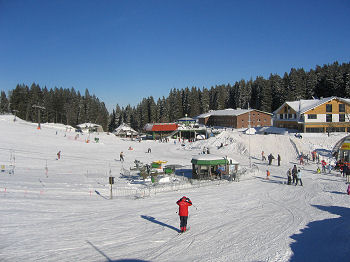Christmas Markets in the Black Forest
Traditional christmas markets take place in many places in the Black Forest every year. The flavour of mulled wine, waffles and fir needles, candlelights and the cosy atmosphere attract the guests every year anew. Besides eating and drinking of course you can find lots of local products for your own or for your christmas gifts.
 Here you find dates and places of the biggest and most beautiful markets:
Here you find dates and places of the biggest and most beautiful markets:
- 26 November - 27 December 2009: Christkindles market in Baden-Baden
- 23 November - 23 December 2009: Christmas market in Freiburg
- 24 November - 23 December 2009: Christmas market in Offenburg
- 26 November - 23 December 2009: Christkindlesmarkt in Karlsruhe
- 28 November - 28 December 2009: Sternlesmarkt in Ettlingen
- 26-29 November 2009: Magical Christmas market in Calw
- 23 November - 22 December 2009: Christmas market in Pforzheim
- 4 December - 13 December 2009: Christmas market in Freudenstadt
- 30 November - 23 December 2009: Advent's market and the world's biggest 'advent calendar house' in Gengenbach
- 27 November - 6 December 2009: Advent's market in Gaggenau
- 27 November - 13 December 2009: Christmas market in Bühl
- 27 November - 20 December 2009: Christmas market in Rastatt
- 28-29 November 2009: Christkindlemarkt in Bad Dürrheim
- 28 November - 23 December 2009: Advent and Christmas market in Lahr
- 10-20 December 2009: Christmas market in Bad Krozingen
- 3-13 December 2009: Christmas market in Lörrach
- 10- 20 December 2009: Christmas market in Rottweil
- 4-6 December 2009: Christmas market Bad Säckingen
- 4-6 December 2009: Christmas market in St. Blasien
- 5-6 December 2009: Christmas market in Titisee-Neustadt
- 10-13 December 2009: Christmas market on the Rosenplatz in Baiersbronn
- 11-13 December 2009: Christmas market in Oberkirch
- 25 December 2009 - 3 January 2010: Triberg Christmas Magic - thousands of lights illuminate the waterfalls and the nature park nearby
 The Feldberg (1493m above sea level) is the highest mountain in the Black Forest, Germany. The Felderg Mountain is located in the south-west of Germany, about 25 km south-east of the city of Freiburg.
The Feldberg (1493m above sea level) is the highest mountain in the Black Forest, Germany. The Felderg Mountain is located in the south-west of Germany, about 25 km south-east of the city of Freiburg. Places nearby
Places nearby
 A very special event took place once again this year in the small community of
A very special event took place once again this year in the small community of  Charcoal burning was an important industry in the Black Forest for a long time. The charcoal was mainly required for ironworks and glass manufacture. Increasingly larger quantities were needed, which meant that vast areas of the Black Forest were bare and not covered by dense forest as they are today. Coal was increasingly used in industry from the 18th century, so that the trees grew back and the forest could recover.
Charcoal burning was an important industry in the Black Forest for a long time. The charcoal was mainly required for ironworks and glass manufacture. Increasingly larger quantities were needed, which meant that vast areas of the Black Forest were bare and not covered by dense forest as they are today. Coal was increasingly used in industry from the 18th century, so that the trees grew back and the forest could recover. The 'Bähnle cycle route' is a cycle route on a disused railway line in the Southern Black Forest from
The 'Bähnle cycle route' is a cycle route on a disused railway line in the Southern Black Forest from  Sure is: the Titisee is one of the most popular places for tourists in the Black Forest, Germany. Every year thousands of people enjoy the great landscape, the possibilities for water sports like swimming, wind-surfing, sailing or a pedalo ride. A very nice option for enjoying the Lake Titisee and the surrounding Black Forest landscape is a sightseeing tours by one of the pleasure boats. Since the waterfront promenade in Titisee-village was converted to a pedestrian zone, the 'Seestrasse' is considered the loveliest street for strolling and shopping in the Southern Black Forest.
Sure is: the Titisee is one of the most popular places for tourists in the Black Forest, Germany. Every year thousands of people enjoy the great landscape, the possibilities for water sports like swimming, wind-surfing, sailing or a pedalo ride. A very nice option for enjoying the Lake Titisee and the surrounding Black Forest landscape is a sightseeing tours by one of the pleasure boats. Since the waterfront promenade in Titisee-village was converted to a pedestrian zone, the 'Seestrasse' is considered the loveliest street for strolling and shopping in the Southern Black Forest.